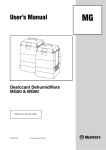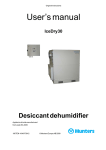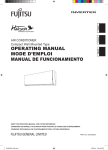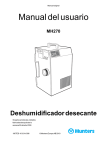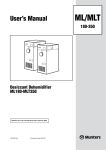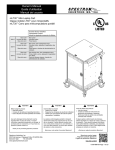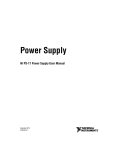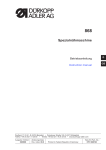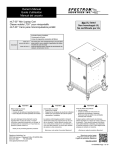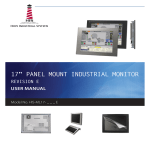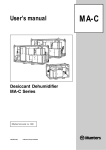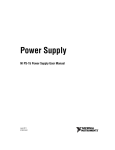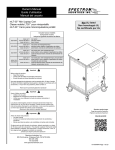Download User`s Manual - du
Transcript
User’s Manual ML/MLT 17E-30E Desiccant dehumidifiers ML17E-MLT30E with electric heater for reactivation Applies to all units manufactured from week 37, 2005 190TEN-1041revC © Munters Europe AB 2005 Table of Contents Important user information .................................. 5 1 2 3 Introduction .................................................... 1.1 General ................................................. 1.2 About this manual ................................. 1.3 Safety and caution measures ................ 1.4 Markings ............................................... 1.5 Supervision of operation ....................... 1.6 Fault indications .................................... 7 7 7 7 7 8 8 Installation ...................................................... 2.1 General ................................................. 2.2 Safety .................................................... 2.3 Moving the equipment ........................... 2.4 Packaging and Delivery Inspection. ...... 2.5 Storing the Equipment .......................... 2.6 Location requirements .......................... 2.7 Ducting .................................................. 2.7.1 General recommendations ......... 2.7.2 Ductwork for Outdoor Air Inlet .... 2.7.3 Ductwork for Wet Air Outlet ........ 2.8 Precautionary measures for units using LI desiccant rotor .................................. 2.9 Electrical Connections .......................... 2.9.1 Mains Supply .............................. 2.10 External humidity transmitter ................ 2.10.1 Location requirements ................ 2.11 Pre-start settings ................................... 2.11.1 Remote start .............................. 2.11.2 Continuous process air fan operation .................................... 2.11.3 Humidity control alternatives ...... 2.11.4 Reactivation temperature ........... 2.11.5 Control accuracy ........................ 2.12 Pre-start checks .................................... 2.12.1 Pre-Start Checklist ..................... 2.13 Airflow Check and Adjustment .............. 2.13.1 General ...................................... 2.13.2 Process fan speed control (IP version only) ............................... 9 9 9 9 10 10 10 11 11 12 12 Operation ........................................................ 3.1 General ................................................. 3.2 Safety .................................................... 3.3 Quick stop ............................................. 3.4 Operating the unit ................................. 3.4.1 Initial start-up, Manual mode (100%) ........................................ 3.4.2 Inital start-up, Automatic mode (AUTO) - regulating to set-point .. 19 19 19 19 20 190TEN-1041revC a163 14 14 14 14 15 15 15 15 15 16 16 16 16 17 17 18 20 20 3.5 3.4.3 Inital start-up, Automatic mode (AUTO) - external control ........... 21 Control Panel ........................................ 22 4 Service and Maintenance .............................. 4.1 Safety .................................................... 4.2 Regular service and maintenance ........ 4.3 Service indicator lamp .......................... 4.3.1 Filter change needed ................. 4.3.2 Service requirements ................. 4.4 Service and Maintenance Schedule ..... 24 24 24 24 24 24 25 5 Fault 5.1 5.2 5.3 Finding .................................................. General ................................................. Safety .................................................... Fault Finding ......................................... 26 26 26 26 6 Dehumidifier design ...................................... 6.1 Product Description ............................... 6.2 IP version .............................................. 6.3 Principle of operation ............................ 6.4 Operating principles, IP version ............ 6.5 Dimensions and service space requirements ......................................... 6.6 Capacity Diagrams ................................ 6.7 Technical specifications ........................ 6.8 Unit’s main components ........................ 6.9 Noise data ............................................. 28 28 28 28 29 Control system ACD ...................................... 7.1 General ................................................. 7.2 Structure ............................................... 7.3 Working with the ACD ........................... 7.4 Operating windows (1-6) ....................... 7.4.1 Window 1A, Internal set-point .... 7.4.2 Window 1B, External set-point .... 7.4.3 Window 1C, External control ...... 7.4.4 Window 1D, Extra set-point ........ 7.4.5 Window 2, Runtime .................... 7.4.6 Window 3, Reactivation temperature ................................ 7.4.7 Window 4, Motor status .............. 7.4.8 Window 5, Reactivation power .... 7.4.9 Window 6, Alarm ........................ 7.5 Basic settings (Windows 10-16) ............ 7.5.1 Window 10, Information ............. 7.5.2 WIndow 11, Continual operation of process air fan ........................ 7.5.3 Window 12, Humidity control alternatives ................................. 35 35 35 35 36 36 37 37 37 38 7 Table of Contents 30 31 32 33 34 38 39 39 39 40 40 41 41 iii 7.5.4 Window 13, Reactivation temperature ................................ 7.5.5 Window 14, Control accuracy ..... 7.5.6 Window 15, P-gain ..................... 7.5.7 Window 16, Integral time constant ...................................... 8 iv 8.2 41 42 42 8.3 8.4 8.5 Installation and operation ...................... 8.2.1 General recommendations ......... Connecting the humidity transmitter ..... Maintenance ......................................... Dimensions ........................................... 44 44 44 45 45 43 HS21 Humidity transmitter ........................... 44 8.1 General ................................................. 44 Table of Contents 190TEN-1041revC Important user information Intended use of the equipment Munters dehumidifiers are intended to be used for the dehumidification of air. All other uses of the equipment, or use which is contrary to the instructions given in this manual, can cause personal injury and/or machine damage. Safety In this publication hazardous activities are indicated and preceded by the common hazard symbol. WARNING! is used in this publication to indicate a possible danger that could lead to personal injury. An instruction is normally given, followed by a short explanation, plus the possible effects if the instruction is not followed. Warranty and obligations The warranty period is 24 months from the date the equipment left our factory, unless otherwise advised in writing. The warranty is limited to a free exchange including free freight of the faulty unit or components, which have failed as a result of faulty quality or defects in manufacture. Munters guarantees that the unit supplied has undergone thorough testing to ensure that it meets the specifications given here. All warranty claims must include proof that the fault has occurred within the warranty period and that the unit has been used in accordance with the specifications. All claims must specify the unit type and manufacturing number. This information is stamped on the unit identification plate, see the section Marking. CAUTION! is used in this publication to indicate a possible danger that could lead to damage to the machine or other equipment and/or cause environmental damage. An instruction is normally given, followed by a short explanation, plus the possible environmental effect if the instruction is not followed. Note! The contents of this document can be changed without prior notice. This publication contains information which is protected by copyright laws. No part of this publication may be reproduced, stored in a system for information retrieval, or be transmitted in any form or in any matter, without Munters’ written consent. Please send any comments regarding the contents of this publication to: Munters Europe AB Dehumidification Division Technical Publications Box 434 191 24 Sollentuna Sweden Tel: +46 (0)8-626 63 00 Fax: +46 (0)8-626 86 18 © Munters Europe AB 2005 190TEN-1041revC NOTE! Used to accentuate supplementary information that is required for problem-free use or optimal use of the unit. Conformity with directives and standards Munters dehumidifiers are designed and manufactured by an EN-ISO 9001 accredited development and manufacturing organization. The unit conforms with the specifications in the Machinery Directive 98/37/EEC, the Low Voltage Directive 73/23/EEC, as amended by Directive 93/68/EEC, and the EMC Directive 89/336/EEC as amended by Directives 92/31/EEC and 93/68/EEC. The standards applied are listed in the EC Declaration of Conformity. Important user information 5 This page left intentionally blank Dehumidifier ML17E-MLT30E 1 Introduction 1.1 General Munters dehumidifiers are designed to dehumidify air efficiently. Munters manufactures a wide range of dehumidifiers that are designed for different uses and applications. Please contact your nearest Munters office if you have any questions regarding the installation of your dehumidifier. For product data, see chapter 6, Dehumidifier design. 1.2 About this manual This manual is written for the user of the dehumidifier and describes the installation, operation, maintenance and basic fault finding. The information structure of the manual is built on numbered chapters and sections. Contents on page 3 gives a quick overview. The different chapters can be used separately to serve their purpose. Figures and tables are numbered in accordance with the actual chapter, e.g. figure 1–3 is picture number 3 and is found in chapter 1. 1.3 Safety and caution measures The contents of this manual include suggested best working practices and procedures. These are provided for guidance only. They are not intended to replace personal responsibility and/or local safety regulations. The dehumidifiers in the ML range are designed to meet the safety requirements, directives and standards listed in the EC Declaration of Conformity. We recommend that the user informs him/herself about the use of safety symbols in this manual by reading the section “Important User Information” on the previous page . Safety information in this manual is contained at the beginning of each of its chapters. 1.4 Markings Figure 1.1 Location of the unit identification plate 190TEN-1041revC 1 Introduction 7 Dehumidifier ML17E-MLT30E Type ML17E Fabr. No 0537 190XXX XXXXX 3 ~ 400V 50Hz M Max 3,1 kW 18 kW 21,5 kW IP54 Munters Europe AB Figure 1.2 Main identification label, example Explanation of "Fabr. no" on the identification plate 05 = year of manufacture, 37 = week of manufacture, 190XXX XXXXX = article number 1.5 Supervision of operation The dehumidifier is controlled and monitored using the control panel located on the front of the unit,see section 3.5, Control Panel. 1.6 Fault indications The red lamp on the control panel lights to indicate the occurrence of a fault. Window 6 of the control system, see section 7.4.9, Window 6, Alarm. shows which function caused the fault indication. 8 1 Introduction 190TEN-1041revC Dehumidifier ML17E-MLT30E 2 Installation 2.1 General The ML Dehumidifier is intended for indoor installation. The unit is inspected and checked prior to leaving the factory to guarantee consistent quality and maximum reliability. If the unit is to be put into storage, prior to installation see section 2.5, Storing the Equipment. 2.2 Safety WARNING! Ensure that the mains power is disconnected from the dehumidifier prior to changing the orientation of the process and dry air connections. WARNING! Low voltage is permanently connected to the inlet main power switch of the unit. In the event of adjustment, maintenance or repair, the unit front covers may only be removed by qualified personnel. CAUTION! The wet air ducting must always be insulated if there is a risk of freezing. The wet air leaving the dehumidifier will, due to high moisture content, condense on the inside duct walls. CAUTION! The main power switch must only be used in an emergency to stop the unit. Since the reactivation fan will also stop, considerable heat can develop in the reactivation heater causing its high temperature protector to trip. Components close to the heat could be damaged. CAUTION! The dehumidifier has been designed to operate at specific process airflows (corresponding to the fan sizes installed) and must not be directly connected to air-conditioning systems. 2.3 Moving the equipment The dehumidifier is delivered on a pallet and must be handled carefully. All panel doors on the unit must be closed during transport. Provided that the dehumidifier is still secured to its delivery pallet, it can be moved using a fork-lift truck. Weight of the dehumidifier can be found in section 6.5, Dimensions and service space requirements. 190TEN-1041revC 2 Installation 9 Dehumidifier ML17E-MLT30E 2.4 Packaging and Delivery Inspection. 1 Check the delivery against the packing list, consignment note, or other delivery documents and check that everything is included and nothing is damaged. 2 Contact Munters immediately if the delivery is not complete in order to avoid installation delays. 3 If the unit is to be put into storage, prior to installation, see section 2.5, Storing the Equipment. 4 Remove all packing materials from the unit and check carefully to make sure that no damage has occurred during transport. 5 Any visible damage must be reported in writing to Munters prior to the start of installation. 2.5 Storing the Equipment The following is important if the dehumidifier is to be stored prior to installation: Place the dehumidifier on a horizontal surface. Do not remove the dehumidifier's packaging. Protect the dehumidifier from physical damage. Store the dehumidifier under cover and protect from dust, frost, rain and aggressive contaminants. 2.6 Location requirements The dehumidifier is only intended for indoor installation. Avoid installing the dehumidifier in a damp environment where there is a risk of water entering the unit or in a very dusty environment. If in doubt, seek advice from Munters. It is important that the intended installation site meets the location and space requirements for the equipment in order to achieve the best possible performance and trouble-free operation. For the unit and service dimensions, see section 6.5, Dimensions and service space requirements. NOTE! 10 It is important, both for maintenance and for service, that the minimum dimensions for service access are complied with. 2 Installation 190TEN-1041revC Dehumidifier ML17E-MLT30E 2.7 Ducting 2.7.1 General recommendations The connections for process and reactivation air are designed in accordance with the recommendations in ISO 7807. The rectangular duct connections contain tapped inserts for M8 screws. NOTE! The dehumidifier has been designed to operate at specific process airflows (corresponding to the fan sizes installed) and must not be directly connected to air-conditioning systems. NOTE! The IP version, see section 6.2, IP version, does not have a process air filter. Process air must therefore be connected to cold/pre-cooled and filtered air via a duct. When installing ductwork between the dehumidifier and the inlet and outlet connections, the following recommendations should be observed: The length of ductwork should be kept as short as possible to minimise static air pressure losses. To maintain performance, all rigid process or reactivation air ductwork joints must be air and vapour tight. The process air ductwork should be insulated to prevent condensation from developing on the outside of the duct whenever the temperature of the air within the duct falls below the dewpoint of the ambient air through which the ductwork is routed. The ducting must always be insulated when there is a risk of freezing. The wet air leaving the dehumidifier will easily cause condensation on the inside of the duct walls due to the high moisture content. This must be avoided by insulating the ducts. Horizontal duct-runs should be installed sloping downwards (away from the dehumidifier) to allow for condensate drainage. On the wet air outlet ducting, suitable condensate drains should be installed at low points in the ductwork. See figure 2.2, Wet air outlet design. Ensure that access for operation and servicing is not restricted when designing and installing ducting. For more information, refer to section 6.5, Dimensions and service space requirements. To reduce noise and/or vibration being transmitted along rigid ductwork, good quality, airtight flexible connections should be fitted. Ducts mounted directly onto the dehumidifier should be adequately supported to minimise the load and stress due to the weight and movement of the ducting. Dampers for balancing the airflows must be installed in the dry air outlet and reactivation air inlet ducts. The correct airflows are essential for 190TEN-1041revC 2 Installation 11 Dehumidifier ML17E-MLT30E maintaining the operating efficiency of the unit. To correct the airflow, see section 2.13, Airflow Check and Adjustment. For the IP version, see section 6.2, IP version process air pressure and flow are adjusted using the frequency converter of the process air fan. In this case, there is no need for a damper in the dry air duct. The total resistance in the process and reactivation ductwork must not exceed the performance rating of the fans fitted in the dehumidifier. For details of minimum available static pressure, see section 6.7, Technical specifications. 2.7.2 Ductwork for Outdoor Air Inlet When bringing outside ambient air into the dehumidifier, the opening to the inlet duct should be located sufficiently high above ground level to prevent the pick-up of dust and debris. The ducting should be designed to prevent rain and snow from being drawn into the dehumidifier. The air inlet must be located away from possible contaminant such as engine exhaust gases, steam and harmful vapours. To prevent the wet (outlet) air humidifying the reactivation (inlet) air, the air inlet for reactivation must be located at least 2 m from the air outlet for wet air. See figure 2.1, Outdoor air inlet design. Rectangular duct Round duct Wire netting, mesh width approx. 10 mm Wire netting, mesh width approx. 10 mm Figure 2.1 Outdoor air inlet design 2.7.3 Ductwork for Wet Air Outlet Wet air ducting should be manufactured in corrosion-resistant material (e.g. stainless steel, aluminium or plastic) and should be capable of withstanding temperatures of up to 100ーC. NOTE! The wet air ducting must always be insulated if there is a risk of freezing. The wet air leaving the dehumidifier will easily cause condensation on the inside of the duct walls due to the high moisture content. Horizontal duct-runs must therefore be installed sloping downwards (away from the dehumidifier) to allow for condensate drainage. The slope should be a minimum of 2 cm per meter of duct. In addition, 5 mm drain holes 12 2 Installation 190TEN-1041revC Dehumidifier ML17E-MLT30E should be drilled at the lowest points in the ducting to prevent water accumulating in the duct, see figure 2.2, Wet air outlet design. Horizontal wet air outlet Vertical wet air outlet Downward slope away from dehumidifier Wet air Wire netting, mesh width approx. 10 mm Wet air Wire netting, mesh width approx. 10 mm To condensate drain Figure 2.2 Wet air outlet design 5 B B 1 C 4 5 2 A A D 3 A Process air inlet 1 Dry air damper B Dry air outlet 2 External filter box (optional) C Reactivation air inlet 3 Duct transition D Wet air outlet 4 Reactivation air damper 5 Outlet duct (wire netting) Figure 2.3 Ducts required for installation. The illustration on the left depicts the IP version with pre-cooling. 190TEN-1041revC 2 Installation 13 Dehumidifier ML17E-MLT30E 2.8 Precautionary measures for units using LI desiccant rotor The dehumidifier comes standard with Munters' high performance rotor HPS (High Performance Silicia gel). If the dehumidifier is delivered with LI rotor (lithium chloride) it is vital to prevent the desiccant rotor from becoming to greatly loaded with moisture when the dehumidifier is switched off. Make sure that no air passing through the rotor has a relative humidity greater than 80% ! We recommend installation of an adjustment damper in the dehumidifier's process and reactivation air inlet. This prevents air with very high relative humidity from inadvertently being drawn through the rotor and into the room. This is particularly important when the process air is drawn from outdoors, or the system has been fitted with a pre-cooler. 2.9 Electrical Connections 2.9.1 Mains Supply The unit is designed for 3-phase AC operation. Each unit is supplied complete with all the internal wiring installed and configured in accordance with the specified voltage and frequency on the identification plate. NOTE! The supply voltage must not differ by more than 10% from the specified operating voltage. The unit must be correctly earthed. The mains power supply is connected directly to the main power switch in the unit. The supply cable and main fuses must be dimensioned to suit the unit being installed. For connection details, refer to the identification plate and Electrical Circuit Diagram or refer to section 6.7, Technical specifications. 2.10 External humidity transmitter The dehumidifier is supplied as standard with a humidity transmitter of type HS21 suitable for wall of duct mounting. This is mounted externally and connected to a terminal block, see the electrical circuit diagram supplied with the unit. The humidity transmitter controls the dehumidifier when the operational mode switch is in the AUTO position, i.e. automatic operation, and also indicates the current Relative Humidity, see section 2.11, Pre-start settings. To ensure functionality, the humidity transmitter should be connected using the cable supplied. If a longer cable is required, use of the same cable type is recommended. If the transmitter cable is longer than approx. 100 metres, there may be voltage drops that could affect the function of the humidity transmitter. 14 2 Installation 190TEN-1041revC Dehumidifier ML17E-MLT30E 2.10.1 Location requirements The humidity transmitter should be mounted 1–1.5 m above the floor and positioned so that it is not exposed directly to dry air from the unit or incoming moist air from opening and closing doors. It must not be placed close to a heat source or so that is it is exposed to direct sunlight. 2.11 Pre-start settings Before starting the dehumidifier for the first time, a number of operating parameters must be set via the ACD control system; see section 7.5, Basic settings (Windows 10-16). Some features require connection to external equipment. For wiring details, refer to the wiring diagrams supplied with this unit. 2.11.1 Remote start The unit can be started and stopped externally with a switch connected between terminal blocks 307 and 308. To do so, the link that is mounted as standard must be removed. 2.11.2 Continuous process air fan operation The default setting is that the process fan starts automatically only when dehumidification is needed. However, continuous process airflow may be desirable even when there is no demand for dehumidification. The process fan can be set to operate continuously, see section 7.5.2, WIndow 11, Continual operation of process air fan. 2.11.3 Humidity control alternatives There are three different ways of controlling the dehumidifier when in the automatic operational mode, see section 7.5.3, Window 12, Humidity control alternatives. 1 The dehumidifier runs to an internally adjustable set-point which is programmed via control system window 1A. 2 The dehumidifier is regulated to an externally adjustable set-point. See display 1B. The external set-point comprises an analogue signal, 0-10 V, between terminal blocks 304 and 306. 3.0 volts, for example, is set-point 30% RH. 3 The dehumidifier's heater is controlled from an external input signal, 0-10 V, see display 1C. The external input signal at input 18 (terminal block 306) controls the heater power regardless of the actual humidity load. 3.0 volt, for example, means that the unit is being run at approximately 30 % heating capacity If you can accept a different relative humidity level during certain times, then it is possible, regardless of which of these three control alternatives is selected, to control the dehumidifier against an additional temporary internally adjustable set value, designated set value 2, see section 7.4.4, Window 1D, Extra set-point. Set value 2 is activated using a closing contact, 190TEN-1041revC 2 Installation 15 Dehumidifier ML17E-MLT30E which might be a timer, for example, between terminal blocks 309 and 310. 2.11.4 Reactivation temperature It is possible to set a maximum reactivation temperature. It is pre-set to 130°C, see section 7.5.4, Window 13, Reactivation temperature. 2.11.5 Control accuracy It is also possible to set the maximum difference between switching on and off, so-called hysteresis, in display 14.The pre-set value is 3 %. For more information, see section 7.5.5, Window 14, Control accuracy. 2.12 Pre-start checks WARNING! The mains power supply is permanently connected to the main power switch in the unit. Adjustments, maintenance and repair work may only be carried out by qualified personnel. 2.12.1 Pre-Start Checklist The following checks are to be carried out before the dehumidifier is started for the first time. 1 Ensure that the main power switch on the control panel is in the position 0. 2 Check the air intake filters for damage and proper fixation and also check that all areas inside the unit are clean. 3 Visually inspect all ducting and duct connections to make sure that all connections have been correctly installed and that there are no signs of damage to the system. Also check that all ducts are free from obstacles blocking the air passage. 4 Remove the lower front panel and check that none of the circuit breakers on the control panel has tripped. For further details, refer to the wiring diagrams provided with the unit. 5 Check that the incoming power supply voltage is correct and that the cables are correctly connected. 6 Check that the humidity transmitter/sensor have been correctly positioned in the room and have been properly connected to the unit, see section 2.10, External humidity transmitter. 7 Set the process and reactivation airflow dampers to the fully open position. For the IP version, the process air fan is run at high speed with the help of the frequency converter, see section 2.13.2, Process fan speed control (IP version only) 16 2 Installation 190TEN-1041revC Dehumidifier ML17E-MLT30E 2.13 Airflow Check and Adjustment 2.13.1 General To obtain the design performance, the dry air and reactivation airflow dampers must be correctly adjusted in accordance with the rated airflow, see section 6.7, Technical specifications. If necessary, please contact Munters to obtain help to order the installation and adjustment of the dehumidifier. The addresses and telephone numbers to Munters can be found on the back of this manual. CAUTION! Failure to correctly adjust the process and reactivation airflows could cause the unit to malfunction. 1 The direction of rotation of the rotor must be checked after connection to the power supply. Open the middle front panel. Start the dehumidifier and check that the rotor is rotating clockwise, i.e. in the same direction as the arrow. 2 By adjusting the dampers installed in the dry air outlet and reactivation air inlet ducts, the process and reactivation airflows can be changed to the required setting. 3 Start the dehumidifier for approximately eight minutes to allow the reactivation heater to reach its normal operating temperature. See chapter chapter 3, Operation 4 Check that the temperature difference between the reactivation air (display 3 ) and the input reactivation temperature is approximately 95°C (tolerance ±5°C). If the temperature differential is outside the tolerance limit of 5 %, adjust the reactivation air damper in small steps (allowing the temperature display to stabilize after each adjustment) until the reactivation temperature reading is within the specified tolerances. EXAMPLE Inlet air temperature 15°C Reactivation air temperature 110°C Temperature increase 95°C 190TEN-1041revC 2 Installation 17 Dehumidifier ML17E-MLT30E 2.13.2 Process fan speed control (IP version only) The process air fan is controlled via a frequency converter that makes it possible to adjust air pressure and flow. This is located behind the lower front panel. For information on use and setting, see the separate frequency converter manual. 18 2 Installation 190TEN-1041revC Dehumidifier ML17E-MLT30E 3 Operation 3.1 General Dehumidifiers ML17 - MLT30 are equipped with a control panel containing main power switch, mode switch, display and indicator lamps. The operating switch on the control panel has two operating positions: 100 % (Full power position) The dehumidifiers fans, rotor and reactivation heater operate continuously at full capacity. AUTO (Automatic position) The dehumidifier fans, rotor and reactivation heater operate when the relative humidity exceeds the desired value (the set-point). If remote start is connected, the switch must be set to on; see section 2.11.1, Remote start. If continual process air operation is selected in the control system, see section 7.5.2, WIndow 11, Continual operation of process air fan, the process air fan continues to run even after the unit has stopped dehumidifying. If the dehumidifier is regulated via an external input signal, see section 7.4.3, Window 1C, External control, the fans and drive motor start when the "remote start" switch is closed, regardless of the existing relative humidity. The reactivation heater is regulated via the input signal. In the case of a power cut, the dehumidifier will restart automatically when the power supply is restored. 3.2 Safety CAUTION! To prevent damage to the fans, the unit must not be run for longer than a few minutes prior to setting-up the process and reactivation airflows. For more information, see section 2.13, Airflow Check and Adjustment. CAUTION! Failure to correctly adjust the process and reactivation airflows could cause the unit to malfunction. 3.3 Quick stop The mode switch is used to start and stop the unit in normal operation. In case of an emergency, use the main power switch on the dehumidifier, see figure 3.5, Control Panel. CAUTION! The main power switch should only be used to stop the dehumidifier in an emergency. Since the reactivation fan will also stop, considerable heat can build up in the reactivation heater, causing its high temperature protector to trip, which can cause damage to components close to the heater. 190TEN-1041revC 3 Operation 19 Dehumidifier ML17E-MLT30E 3.4 Operating the unit 3.4.1 Initial start-up, Manual mode (100%) 1 Move the main power switch to the "1" position and check that the ACD display is switched on. 2 The three lamps should flash twice as a check on the lamp function. 3 Move the operating switch to the 100 % position. Check that: The white lamp illuminates to indicate that the unit is dehumidifying. The process and reactivation air fans have started, see section 7.4.7, Window 4, Motor status. The drive motor is operating, see section 7.4.7, Window 4, Motor status. 4 Allow the unit to operate for approximately 8 minutes to ensure that the operating conditions have stabilised. Check that the temperature of the reactivation heater is rising, see section 7.5.4, Window 13, Reactivation temperature. 5 Move the operating switch on the control panel to the "0" position. 6 In order to dissipate any residual heat, the reactivation air fan and the drive motor will continue to run after the unit has been switched off until the reactivation temperature has fallen below approx. 50°C. 7 Check that the reactivation air fan and the drive motor stop once the reactivation temperature has fallen below approx. 50°C. A few minutes delay is quite normal. 3.4.2 Inital start-up, Automatic mode (AUTO) - regulating to set-point In order to operate the unit in automatic mode to a desired set-point, a humidity transmitter must be connected. If the system is equipped with "remote start", this switch must be closed. The following applies regardless of whether the unit is regulated by a set-point set via the unit display, see section 7.4.1, Window 1A, Internal set-point (display 1A), external, see section 7.4.2, Window 1B, External set-point (display 1B) or via an extra set-point, "nighttime reduction", see section 7.4.4, Window 1D, Extra set-point (display 1D). 1 Move the main power switch to the "1" position and check that the power connection indicator is displayed. This consists of the ACD display being switched on and the small green light on the display unit flashing. 2 Adjust the set value for the minimum possible relative humidity (%RH). 3 Move the operating switch to the AUTO position. Check that: The white lamp illuminates to indicate that the unit is dehumidifying. 20 3 Operation 190TEN-1041revC Dehumidifier ML17E-MLT30E The fans and drive motor have started, see section 7.4.7, Window 4, Motor status The heater is running, see section 7.4.8, Window 5, Reactivation power Reactivation temperature rises, see section 7.4.6, Window 3, Reactivation temperature 4 The set-point for relative humidity gradually rises and check that the unit switches off when the set-point corresponds with the actual relative humidity. 5 Then reduce the set value one percent at a time and make a note of the set value at which the unit restarts. The difference between the real RH value and the current set value is the regulation accuracy, hysteresis, for which the humidity control is set. This value can be changed on display 11. 6 Move the operating switch on the control panel to the "0" position. 7 In order for the reactivation heater to cool down, the reactivation air fan and the drive motor continue to operate after the unit has shut down, until the temperature of the heater falls below 50°C. 8 Check that the reactivation air fan and the drive motor stop when the reactivation temperature drops below approx. 50°C . 9 Adjust the desired set value of RH. 3.4.3 Inital start-up, Automatic mode (AUTO) - external control When the unit is controlled via an external input signal (0 - 10 V), the following measures should be taken before first start-up. . 1 Operate the main power switch to the “1” position and check the indication for “power supply connected”. The ACD display should be illuminated. 2 Set the external input signal to approx. 10 V. 3 Operate the Mode switch on the control panel to the AUTO position. Check that: The white lamp illuminates to indicate that the unit is dehumidifying. The fans and drive motor have started, see section 7.4.7, Window 4, Motor status Heater output is connected, see section 7.4.8, Window 5, Reactivation power Reactivation temperature rises, see section 7.4.6, Window 3, Reactivation temperature 190TEN-1041revC 3 Operation 21 Dehumidifier ML17E-MLT30E 4 Reduce input signal voltage to approx. 6 V. Check that heater output is approx. 65%. 5 Reduce input signal voltage to approx. 3 V. Check that heater output is approx. 35 %. 6 Reduce the voltage to 0 V and check that the heater power is completely switched off. 7 Move the mode switch on the control panel to position "0". Check that the dehumidifier shuts down once reactivation temperature has dropped below 50 °C. Swich off "remote start" if it is engaged. 3.5 Control Panel Figure 3.1 Control Panel Item. Switch/Indicator Function 1 Main Power Switch When the main power switch is in the ”0” position, the unit is not powered beyond the switch. When the main power switch is in the ”1” position, the dehumidifier can be started. 2 Control system ACD See chapter 7 for information about the functions of the control system. 3 Mode switch With the mode switch in the “100%” position, the dehumidifier will operate in manual mode. In this position, the unit will operate continuously (full capacity).There may be a brief delay before the unit starts. When the mode switch is in the ”AUTO” position, the dehumidifier runs automatically and is controlled towards an internally adjustable relative humidity set value or via an external input signal. When the mode switch is in the ”0” position, the dehumidifier is switched off but may continue to run until it has cooled down. 4 White lamp (RUN) Illuminates when the unit dehumidifies. 5 Red lamp (ALARM) Illuminates with a steady glow when an alarm has triggered. Check window no. 6 to see which alarm has triggered. 22 3 Operation 190TEN-1041revC Dehumidifier ML17E-MLT30E Item. 6 Switch/Indicator Yellow lamp (SERVICE) Function Illuminates when a filter change is required, see section 7.4.9, Window 6, Alarm or when the dehumidifier has reached the number of operating hours at which maintenance should be carried out, see section 7.4.5, Window 2, Runtime. Table 3.1 Function of the Control Panel 190TEN-1041revC 3 Operation 23 Dehumidifier ML17E-MLT30E 4 Service and Maintenance 4.1 Safety WARNING! Adjustments, maintenance and repair work may only be carried out by qualified personnel. 4.2 Regular service and maintenance Munters dehumidifiers are designed for long-term, continual usage with a high degree of reliabilty. As with all machinery, regular service and maintenance is required to keep the dehumidifier in optimal condition so that it works most efficiently. Service and maintenance interval lengths are primarily determinded by operating conditions and the environment in which the unit is installed. For example, if the process air contains a lot of dust, preventative maintenance should be carried out at shorter intervals. The same also applies if the dehumidifier works intensively. Below is an example of an ordinary service and maintenance program, see section 4.4, Service and Maintenance Schedule. Besides commissioning the unit, four different service programs (A-D) should be implemented at different time intervals. Alternatively, the Service Department at Munters can propose a service program adapted to suit local conditions, depending on how the unit is working and on the type of environment. The ML dehumidifier has a service reminder indicator in the control system, see below. When installing and commissioning, an estimate should be made of the number of operating hours to the next service. This agreed value is programmed in by Munters' personnel. 4.3 Service indicator lamp 4.3.1 Filter change needed The yellow service lamp indicates that a filter change or a general service is needed. When the yellow lamp lights, follow these steps: Choose window 6 in the control system to find out why the service lamp is lit. If "Service 0001" is displayed, the reactivation filter must be changed. If "Service 0002" is displayed, the process air filter must be changed. Open the filter cover and change the filter. 4.3.2 Service requirements If neither of the indicators mentioned above are shown in window 6, go to window 2. If window 2 shows "Service 0000" or a negative value, the dehumidifier has reached the number of operating hours where a general service is recommended. Contact Munters service department. 24 4 Service and Maintenance 190TEN-1041revC Dehumidifier ML17E-MLT30E Window 2 shows the number of operating hours until the next service is needed. A minus sign before the number of hours indicates that the service should already have been carried out. Below is an example of an ordinary service and maintenance program. 4.4 Service and Maintenance Schedule Service work Service level Start A B A B A C A B A B A D Operating time in hours 0 4000 8000 12000 16000 20000 24000 28000 32000 36000 40000 44000 48000 Calendar time in months 0 6 12 18 24 30 36 42 48 54 60 66 72 Inspection, replace filter if necessary, function controls X X X X X X X X X X X X X Preventive inspection incl. safety check X X X X X X X Measuring capacity, rotor inspection X X X X X X X Replacing over-temperature protection X Inspect drive belt and backing rollers and replace if necessary X X X Drive motor replacement X X Examining fans, impellers, motor, bearings X X Examining electrical and control systems, function check X X X X X X X Calibrating the humidity control equipment and the sensors X X X X X X Calibrating the temperature control equipment and the sensors X X X X X X Inspecting rotor housing, replacing rotor gaskets if necessary X Table 4.1 Service and maintenance schedule 190TEN-1041revC 4 Service and Maintenance 25 Dehumidifier ML17E-MLT30E 5 Fault Finding 5.1 General The purpose of this chapter is to provide guidance in basic fault finding and provide instructions for corrective actions to remedy any faults. Wiring diagrams can be useful when fault finding. 5.2 Safety WARNING! Adjustments, maintenance and repairs must only be carried out by qualified personnel. 5.3 Fault Finding The red alarm lamp together with the ACD windows constitute the primary source of information for fault finding when an alarm has been triggered and the unit has stopped. An alarm indicator is reset automatically once the problem that triggered the alarm has been rectified. Go through the fault localisation list below before contacting Munters. The list provides help in identifying types of faults that are easy to remedy without the assistance of specially trained personnel. Always switch off the main power switch before removing the unit's panels. Fault Symptom Unit has stopped The unit is in AUTOmode and has stopped 26 Indicators Lamps and display all off The display is active. Possible cause Corrective Action Power supply failure. Check power supply to the unit. Main power switch (No.1) is in the “0” position. Operate the main power switch to the “1” position and check that the display is active and indicates the latest settings, and that the three lamps are flashing as they do during lamp test. Fuses FU27 and FU28 have tripped. Investigate the cause of the fault and rectify. Reset fuses. Circuit Breaker QM25 tripped due to a wiring fault. Investigate the cause of the fault and rectify. Reset QM25. If the fault re-occurs, contact Munters Product Service. There is no need for dehumidification If remote start is selected, it has been switched off Switch on the remote start switch The mode selector has been set to the AUTOautomatic position by mistake, although no humidistat has been connected. Set the mode selector switch to the 100 %position and check that the unit starts. Humidistat fault (AUTOmatic mode). Set the mode switch to AUTOmatic mode and check the humidistat by seeing whether the dehumidifier starts when the humidistat set-value is reduced to less than the value for the actual relative humidity (RH). Reset the humidistat set-value after the check. If necessary, replace the humidistat. 5 Fault Finding 190TEN-1041revC Dehumidifier ML17E-MLT30E Fault Symptom Indicators Possible cause Corrective Action Unit has stopped The red lamp is on and A-alarm no. 1 is shown on display 6. The high temperature cut-out BT33 has tripped, either due to an obstruction in the reactivation airflow or because the reactivation airflow has been set too low. Leave the unit to cool down. Check that the air inlet, outlet ducts and filters are free from obstructions and are not clogged with dirt. Check and adjust the reactivation airflow, see section 2.13, Airflow Check and Adjustment. Unit has stopped The red lamp is on and display 6 is showing: Loss of performance: The dehumidifier is in operation but is not controlling the humidity. General: Set the mode switch to "0" to reset the alarm once the fault has been corrected. If the fault re-occurs, contact Munters Product Service. A-alarm no. 2 Rotor has stopped. A-alarm no. 3 Reactivation fan is not working A-alarm no. 4 Unit in operation. Investigate cause of alarm and rectify. Check that the drive belt has not snapped - the circuit breaker has tripped Reset QM21. - some other cause Contact Munters Product Service. Process air fan is not working - the circuit breaker has tripped Reset QM23. - some other cause Contact Munters Product Service. A-alarm no. 5 Over-temperature in drive motor Leave the motor to cool down and rectify the cause A-alarm no. 6 Reactivation heater is not working Reset QM12 - 16. A-alarm no. 8 Frequency converter error (IP version only) Check the frequency converter manual for type of error and remedy A-alarm no. 9-11 Reactivation heater is faulty Contact Munters Product Service. The yellow lamp lights and display 6 shows Service no. 1. - Reactivation filter clogged Replace filter Service no. 2 - Process air filter clogged Replace filter According to display no. 3, the temperature rise across the reactivation unit is too low. Check the function of the reactivation heater. Reactivation and process airflows do not correspond to the rated airflows. Check and adjust the reactivation and process, see section 2.13, Airflow Check and Adjustment. The humidistat is not working properly Check the function of the humidistat and that it is connected in accordance with the manufacturer's recommendations, see section 8, HS21 Humidity transmitter . Table 5.1 Fault Finding 190TEN-1041revC 5 Fault Finding 27 Dehumidifier ML17E-MLT30E 6 Dehumidifier design 6.1 Product Description The ML Series desiccant dehumidifiers are designed to efficiently dehumidify the air in low moisture applications. They are equipped with an encapsulated rotor unit. The rotor casing is constructed of durable thermoset plastic and contains isolated sections that provide a precise balance for the dehumidification, reactivation and heat recovery airflows. Its ruggedly formed metal frame and access panels are manufactured of stainless steel. The electrical control system conforms to EN60204 (IEC204) standards. The electrical components are rail-mounted and are constructed of halogen-free plastic. The electrical system has been designed for up to 500 V and 60ーC. The ML series dehumidifiers conform to both harmonised European standards and to CE marking specifications. 6.2 IP version When cold process air is to be dehumidified, often in conjunction with a pre-cooler, condensate will readily form on the inlet side of the dehumidifier. ML-series dehumidifiers can therefore be supplied in an IP version in which the process air fan is encased in a specially insulated box so as to hinder the formation of condensation. 6.3 Principle of operation 1 Process air 2 Dry air 3 Reactivation air 4 Wet air 4 2 3 1 Figure 6.1 Operating principles The desiccant rotor structure comprises a large number of narrow and parallel air channels, processed to a composite material that is highly effective in attracting and retaining water vapour. 28 6 Dehumidifier design 190TEN-1041revC Dehumidifier ML17E-MLT30E The rotor is exposed in sectors to different airflows. The airflow that is to be dehumidified is called process air (1) and passes through the largest sector of the rotor. The moisture in the process air is deposited into the rotor structure and the process air will then leave the rotor as dry air (2). While the rotor rotates slowly the incoming process air always meets a dry rotor structure, thus creating a continuous dehumidification process. The airflow that is used to reactivate (dry) the rotor structure is called reactivation air (3) and is first heated. Passing through the smallest sector of the rotor, in the opposite direction to the process airflow, the reactivation air removes the deposited moisture and leaves the rotor as wet air (4) – warm, moist air. 6.4 Operating principles, IP version 1 Process air 2 Dry air 3 Reactivation air 4 Wet air 4 2 3 1 Figure 6.2 Operating principles for IP version The operating principles are the same in the IP version, but the process air inlet is designed to receive cold, wet air. 190TEN-1041revC 6 Dehumidifier design 29 Dehumidifier ML17E-MLT30E 6.5 Dimensions and service space requirements Scaled and dimensioned AutoCAD drawings are available in Munters’ DryCAD program (can be ordered from the nearest Munters office). Z Y B N J X A N F 2 OD 4 OE M 1 C H 3 L G P P B F 560 107 125 400 1 Process air inlet 2 Dry air outlet 3 Reactivation air inlet 4 Wet air outlet 125 107 62 125 125 125 125 62 Ø 315 C L= 60 H 435 435 Figure 6.3 Dimensions and space requirements (IP version on bottom right) Model Dimensions (in mm) A B C ØD ØE F G H J L M N P ML17 1200 875 1640 315 200 568 460 956 608 460 424 48 ML23 1200 875 1640 315 200 568 460 956 608 460 424 48 MLT30 1200 875 1640 315 200 568 460 756 608 460 424 48 (1) (1) Z (1) Weight (kg) X Y 438 200 950 700 280 438 200 950 700 285 438 200 950 700 270 (1) Space for service. Table 6.1 Dimensions and service space requirements 30 6 Dehumidifier design 190TEN-1041revC Dehumidifier ML17E-MLT30E 6.6 Capacity Diagrams Approximate capacity in kg/hr. Please contact your nearest Munters office or refer to Munters’ DryCad program for more detailed information. NOTE! 20 The below figures are based on a nominal (1/1) airflow. (kg/h) (kg/h) 18 80%RH ML17 16 3. 14 2. 12 60%RH 24 40%RH 20 ML23 3. 2. 16 10 8 12 6 8 4 2 0 28 4 1. -10 0 10 20 30 (°C) 1. 0 -10 0 10 20 30 (°C) (kg/h) 20 18 MLT30 16 80%RH 3. 14 60%RH 2. 12 40%RH 1 Process air temperature °C 2 Process air relative humidity % RH 10 3 Dehumidification capacity, kg/h (moisture removed in kg/hour) 8 6 4 2 1. 0 -10 0 10 20 30 (°C) Figure 6.4 Capacity Diagrams 190TEN-1041revC 6 Dehumidifier design 31 Dehumidifier ML17E-MLT30E 6.7 Technical specifications The following data is applicable to units fitted with electric reactivation heaters. Model ML17 ML23 MLT30 Process air Figures quoted are nominal, based on fan inlet temperature of 20°C, and an air density of 1.2 kg/m3 Rated airflow (m3/s) Rated airflow (m3/h) Minimum available static pressure (Pa) Fan motor power (kW) 0,472 1700 300 2,0 0,639 2300 300 3,8 0,833 3000 300 3,8 0,175 630 300 1,1 0,236 850 300 1,1 0,175 630 300 1,1 Current (Amps/Phase) 3~ 50 Hz 230V 59,9 83,7 66,5 Current (Amps/Phase) 3~ 60 Hz 230 V 59,3 82,1 64,9 Current (Amps/Phase) 3~ 50 Hz 380 V 35,8 49,9 39,4 Current (Amps/Phase) 3~ 60 Hz 380 V 35,5 49,7 39,2 Current (Amps/Phase) 3~ 50 Hz 400 V 34,5 48,2 38,2 Current (Amps/Phase) 3~ 50 Hz 415 V 33,6 47,1 37,4 Current (Amps/Phase) 3~ 60 Hz 440 V 31,5 43,5 34,5 Current (Amps/Phase) 3~ 60 Hz 460 V 30,7 42,5 33,7 Current (Amps/Phase) 3~ 60 Hz 480 V 30,0 41,9 33,5 Current (Amps/Phase) 3~ 50 Hz 500 V 27,7 41,0 33,1 95 18,0 95 24,6 95 18,0 Drive Motor Power (W) Air Filtration (Standard) Electrical protection standard, dust and water resistant (main casing) Fan Motor Winding Insulation Class Drive Motor Winding Insulation Class High Temperature Cut-Out (°C) 10 G3 (EU3) IP54 Class F Class F 160 +/- 5 10 G3 (EU3) IP54 Class F Class F 160 +/- 5 10 G3 (EU3) IP54 Class F Class F 160 +/- 5 Contactor Coil Voltage External (potential-free) output contacts 230 V AC 2 A, 50 V AC (max.) Reactivation air1 Rated Airflow (m3/s) Rated Airflow (m3/s) Minimum Available Static Pressure (Pa) Fan motor power (kW) Rated Current Reactivation Heater Temperature rise across heater (°C) Reactivation Heater Power (kW) Other Technical Data Table 6.2 Technical specifications 32 6 Dehumidifier design 190TEN-1041revC Dehumidifier ML17E-MLT30E 6.8 Unit’s main components 1 Process fan motor 2 Process air impeller 3 Reactivation fan motor 4 Reactivation air impeller 5 Process air filter 6 Reactivation air filter 7 Rotor 8 Upper rotor cover 9 Lower rotor cover 10 Rotor sealing ring 11 Roller, belt guide 12 Drive belt 13 Reactivation heater 14 Drive motor 15 Pulley, belt drive 16 Electrical control panel Figure 6.5 ML17 - MLT30 Layout drawing (version with electric reactivation heater) 190TEN-1041revC 6 Dehumidifier design 33 Dehumidifier ML17E-MLT30E 6.9 Noise data The following sound data refers to MLT30. Other sizes do not exceed these values. Noise for Correction Kok dB at ISO-band centre frequency, Hz dB(A) Lwt 63 125 250 500 1000 2000 4000 8000 Duct 1 NA 101 -10 -2 -9 -13 -20 -22 -27 -33 Duct 2 NA 102 -3 -5 -13 -20 -20 -19 -21 -26 Duct 3 NA 94 -5 -6 -5 -17 20 -21 -23 -27 Duct 4 NA 88 -2 -6 -12 -25 -31 -31 -33 -35 Room 64 90 -1 -8 -14 -16 -20 -23 -26 -31 NOISE PATHS TO SURROUNDINGS: 1 Ductwork for dry air 2 Ductwork for process air 3 Ductwork for reactivation air 4 Ductwork for wet air NOISE PATHS TO EQUIPMENT ROOM: SYMBOLS: Lwt = Total noise level dB (rel. 10-12 W) Lw = Noise power level in octave band dB (rel. 10-12 W) Kok = Correction for calculating Lw (Lw = Lwt + Kok) dB(A) = Rated noise level at 100m2 room absorption 34 6 Dehumidifier design 190TEN-1041revC Dehumidifier ML17E-MLT30E 7 Control system ACD 7.1 General The dehumidifier is equipped with a programmable control system, ACD. There is a limited ability to adapt the system to meet special application needs that may arise. The dehumidifier is delivered with the ACD system set to standard values. These can normally be adjusted on site as part of the installation and start-up process. Figure 7.1 ACD unit 7.2 Structure ACD is made up a number of windows for operating (no. 1-6) and basic settings (no. 10-16). Normally, the basic setting component is only used to set basic values in conjunction with the initial start-up. 7.3 Working with the ACD Figure 7.2 Push-button functions 190TEN-1041revC 7 Control system ACD 35 Dehumidifier ML17E-MLT30E Press > or < to page forward or back between the different operating windows. Hold < depressed for three seconds to shift to the window for basic settings. Then press > or < to page forward or back between the different operating windows. Press ∨ or ∧ to change the set value. If you cannot make your way back to the starting point, the unit must be switched off with the mode switch. Once the unit has shut down completely, switch off the main power switch and turn it on again to reset the system. The buttons (DEL, ALT, ESC, OK) are only used for basic programming and configuration of the control system and are not to be used for normal operation. If the "OK" button is accidentally pressed, go back by pressing "ESC." If the "*" button is accidentally pressed, go back by pressing "*" again. If the main power switch of the dehumidifier is in position "0", i.e. there is no power supplied, the window is dark. No settings can be made during this time. When the dehumidifier has mains power, i.e. the main power switch is in position "1," the window is illuminated and the most recently used operating window (1-6) is displayed. A small green lamp on the right-hand side of the window flashes to confirm communication with the control system. Illumination of the red lamp indicates a fault in the internal control network. 7.4 Operating windows (1-6) Window for monitoring. Some settings can be made here. Window 1, which is the base window, has three variants – 1A, 1B and 1C – depending on which humidity regulation principle is selected for the dehumidifier. The system automatically displays the window relevant to the selected type of humidity regulation. Selection of humidity regulation principle is made in window 12; see section 7.5.3, Window 12, Humidity control alternatives. 7.4.1 Window 1A, Internal set-point In most cases, this is the starting window displayed when humidity transmitter HS21 is connected; see chapter 8. This window shows current relative humidity (%RH) and the set-point the dehumidifier is set to work toward (SETV. 1). The set-point is set in this window. Press ∨ or ∧ to change the set value. 1A --HUMIDITY -HUMIDITY +048% RH SET V. 1 +050% RH Figure 7.3 window 1A 36 7 Control system ACD 190TEN-1041revC Dehumidifier ML17E-MLT30E HUMIDITY actual Relative Humidity in % RH SET V. 1 Set value Relative Humidity in % RH 7.4.2 Window 1B, External set-point Window 1B is automatically displayed when the dehumidifier is regulated to a set-point set outside of the unit via an external signal. This window is solely for information. No settings can be made in this window. 1B --HUMIDITY -- HUMIDITY +048 % RH EXT. SET V +050 % RH Figure 7.4 window 1B HUMIDITY Actual Relative Humidity in % RH EXT.SET V External Set Value Relative Humidity in % RH 7.4.3 Window 1C, External control Window 1C is displayed if the dehumidifier's reactivation heater is controlled directly via an external input signal 0 - 10 V. Input signal size is displayed in 0.1 V, i.e. 3.3 V is displayed as 33. In practice, 3.3 V means that 33% of the reactivation heater power is connected. 1 C -- CONTROL -HUMIDITY +048%RH EXTERN CONTROL Signal 0,1V +033 Figure 7.5 window 1C HUMIDITY Actual relative humidity in % RH EXTERNAL CONTROL Voltage of input signal in units of 0.1 V 7.4.4 Window 1D, Extra set-point If at certain times a higher relative humidity can be accepted, an alternative set-point can be programmed for such. The set-point is set in this window. Press ∨ or ∧ to change the set value. The unit is then controlled by the input signal from the humidity transmitter against the alternative set value, which is called “Set Value 2” here. Window 1D is automatically displayed when the extra set-point regulates the dehumidifier. For further information on connecting an extra set-point, see section 2.11.3, Humidity control alternatives. 190TEN-1041revC 7 Control system ACD 37 Dehumidifier ML17E-MLT30E 1 D --HUMIDITY -HUMIDITY +048% RH SETV. 2 +050% RH Figure 7.6 window 1D HUMIDITY Actual Relative Humidity (%RH) SET V 2 Set Value 2 From this window, you can only go back to the base window (window 1A - 1C) from which you came. Press button <. 7.4.5 Window 2, Runtime The runtime of the fans and reactivation heater can be read from window 2. The running hours remaining before the next scheduled maintenance service are also shown here, see chapter 4, Service and Maintenance. This window is solely for information. No settings can be made in this window. 2 -- RUNTIME -PRO.FAN +001890 h HEATER +001890 h SERVICE +001110 h Figure 7.7 window 2 FANS Fan runtime HEATER Running hours reactivation heater SERVICE Running hours remaining to next recommended maintenance service. 7.4.6 Window 3, Reactivation temperature A set-point for reactivation air temperature can be specified. This set-point (max. value) and current reactivation temperature can be read from this window. 3 -- REACT.TEMP -R-TEMP + 105 C SETV.TEMP + 120 Figure 7.8 window 3 38 R-TEMP Current reactivation temperature SETV. TEMP Set value for reactivation temperature 7 Control system ACD 190TEN-1041revC Dehumidifier ML17E-MLT30E The set-point is set in window 13 among basic settings; see section 7.5.4, Window 13, Reactivation temperature 7.4.7 Window 4, Motor status Window 4 provides a quick overview as to whether the rotor as well as the process and reactivation fan motors are running. ”On” is denoted by ”001” and ”Off ” by ”000”. 4 -- MOTORS -PROCESS FAN + 001 REACT. FAN + 000 DRIVE MOTOR + 000 Figure 7.9 window 4 PROCESS FAN Process fan REACT. FAN Reactivation fan DRIVE MOTOR Drive motor for dehumidifier rotor 7.4.8 Window 5, Reactivation power Window 5 displays how much of the reactivation heater's total power is used at the time of reading (specified in percent). When the gas burner is used for reactivation, it is vital to adjust the values in this window so that the min. and max. values are correct. See separate supplementary document for adjusting max. and min. values for the gas burner. See section 3.5.7-8 in the supplement. 5 -- HEATER -HEATER EFFECT + 067 % Figure 7.10 window 5 HEATER EFFECT Reactivation heater power being used 7.4.9 Window 6, Alarm Window 6 contains a number of alarm functions. Each type of alarm is represented by a specific digit. For a description of corrective actions for each alarm, see chapter 5, Fault Finding. The red lamp on the dehumidifier illuminates with a steady glow if an alarm is triggered; see section 3.5, Control Panel. The alarm indicator goes out automatically when the cause has been rectified. When an A alarm is triggered, the dehumidifier stops. If a filter alarm is triggered, the dehumidifier continues working. The dehumidifier is equipped with the following alarms 190TEN-1041revC 7 Control system ACD 39 Dehumidifier ML17E-MLT30E A-alarm 1 Excess temperature, reactivation heater 2 Rotor stop 3 Reactivation fan 4 Process air fan 5 Drive motor 6 Reactivation heater 7 For gas heater only 8 Frequency converter error (IP version only) 9 -11 Contact Munters Service 1 Dirty reactivation filter 2 Dirty process air filter 3 Maintenance required 7.5 Basic settings (Windows 10-16) Note that all settings in windows 10-16 can only be made with the mode switch in position "0". Press > or < to page forward or back between the different operating windows. Page between different windows as described in section 7.3, Working with the ACD, i.e. with buttons > or <. To access the operating windows, hold button < depressed at least 3 seconds. If you switch to operating windows 1-6, the most recently active window is displayed. If a window is inactive for approx. 30 seconds, the programme returns to the most recently activated operating window. 7.5.1 Window 10, Information The program version of the ACD Program is shown here. This version number is often needed during contacts with Munters. 10 -- MUNTERS -Software XX.XXXX Sweden , XXX.XXXX Figure 7.11 Information window 40 7 Control system ACD 190TEN-1041revC Dehumidifier ML17E-MLT30E 7.5.2 WIndow 11, Continual operation of process air fan In certain applications, the process air fan can run continuously irrespective of whether or not dehumidifying is in progress. This will function only when the dehumidifier is in the ”AUTO” mode. Continual process air operation is set in this window. Press ∨ or ∧ to change the set value. 11 -- SETUP -- CONT. PRO FAN + 001 ( 0 = NO 1 = YES ) Figure 7.12 window 11 If continuous process air operation is not selected, the fan will function as normal. This means that it will only work when dehumidification is needed. 001 Yes, continuous operation 000 (Preset) No, not continuous operation 7.5.3 Window 12, Humidity control alternatives This window is used to program which type of humidity control is relevant. A digit representing the seleted type (see below) is set in the window. This setting determines which of the operating windows (1A - 1C) will be displayed in window mode 1. 12 -- SETUP -HUM. CONTROL ? (0=Int.) +000 (1=Ext. 2=Contr) Figure 7.13 window 12 000 Internally set set-point, set in window 1A 001 Externally set set-point, displayed in window 1B 002 External regulation of reactivation heater, see window 1C 7.5.4 Window 13, Reactivation temperature A maximum value for reactivation temperature can be programmed in this window (beween 100°C - 140°C). Press ∨ or ∧ to change the set value. 13 -- SETUP -- SET VALUE R-. TEMP +120 C ( 100 - 140 ) Figure 7.14 window 13 190TEN-1041revC 7 Control system ACD 41 Dehumidifier ML17E-MLT30E 7.5.5 Window 14, Control accuracy Control accuracy, i.e. the difference (hysteresis) between activation and deactivation in automatic operating mode, is set here. Press ∨ or ∧ to change the set value. A hysteresis value of 2 % means that the unit will start when the sensor value is 2 % (percent) above the set value and stop when the sensor value is 2 % below the set value. Example: With a set value of 30 % and hysteresis 2%, the dehumidifier will start at 32 % and stop when the Relative Humidity (RH) of the air has dropped to 28 %. The value can be set between 1 and 10 %. 14 -- SETUP -HYSTERESIS +/- +004 % ( 1-10 ) Figure 7.15 window 14 7.5.6 Window 15, P-gain A value between 0 and 9 for the proportaional band is set in this window. 15 --- SETUP --REGULATOR P-GAIN +200 ( 100 = 1 ) Figure 7.16 window 15 Example - to set the value 4 - press ∨ or ∧ to change the value in the window to +400 (400=4) PROPORTIONAL BAND A = TOO BIG B = TOO SMALL C = CORRECT Figure 7.17 P-gain 42 7 Control system ACD 190TEN-1041revC Dehumidifier ML17E-MLT30E 7.5.7 Window 16, Integral time constant An integral time constant can be programmed in this window. Time can be set between 0 and 999 seconds. Press ∨ or ∧ to change the value. 16 --- SETUP --REGULATOR I-TIME +200s Figure 7.18 window 16 Figure 7.19 Integral time constant ... 190TEN-1041revC 7 Control system ACD 43 Dehumidifier ML17E-MLT30E 8 HS21 Humidity transmitter 8.1 General When an ACD control system is delivered, it comes with an HS21 humidity transmitter for fitting to a wall or duct. The HS21 is a 2-wire indicator that is placed where the humidity of the air is to be controlled. See the instructions below for correct location. In practice the HS21 works in a range of 0 - 99 % RH. Every transmitter is accurately calibrated before being sent out, and so they do not require any further adjustment prior to installation. 8.2 Installation and operation NOTE! Never remove the dust filter from the transmitter's cover as the transmitter could easily be damaged without this protection. 8.2.1 General recommendations The relative humidity of the air (% RH) is affected by the temperature. In order to measure the air's relative humidity accurately, the transmitter's bulb must therefore be located where the temperature is representative of the air that is to be measured. This is why the location of the transmitter can be of crucial importance to the accuracy of the result of the measurement. A good result can be guaranteed by following the guidelines given below. 1 Install the bulb where the humidity, temperature and air pressure are all representative of the environment that is to be measured. 2 Where a transmitter is mounted on a duct, ensure that the airflow is at least 1 m/s, so that variations in the temperature are detected quickly. 3 Avoid placing the transmitter in the direct vicinity of: heat sources, cooling batteries, warm or cold walls, in direct sunlight or anywhere else where the temperature is not representative. 4 The transmitter must be fitted with the bulb pointing downwards to prevent condensed water running into the transmitter. If this is not possible, it should be mounted horizontally. 8.3 Connecting the humidity transmitter The humidity transmitter is connected to terminal blocks 301, 302 and 303, see also the accompanying electrical circuit diagram. 44 8 HS21 Humidity transmitter 190TEN-1041revC Dehumidifier ML17E-MLT30E 8.4 Maintenance The dust filter should be cleaned at regular intervals determined by the environment in which the transmitter operates. Clean the filter using a fine brush. If this does not clean it sufficiently, the filter must be replaced. To do this, unscrew the filter from the transmitter. 8.5 Dimensions 190TEN-1041revC 8 HS21 Humidity transmitter 45 This page left intentionally blank AUSTRALIA Munters Pty NORTH ALBURY Tel: +61 (0)260 256 422 Fax: +61 (0)260 258 266 CHINA Munters Beijing Ltd BEIJING Tel: +86 (0)10 80 481 121 Fax: +86 (0)10 80 483 493 GERMANY Munters GmbH HAMBURG Tel: +49 40 734 16 01 Fax: +49 40 734 11 11 [email protected] NETHERLANDS Munters Vochtbeheersing ALPHEN a/d RIJN Tel: +31 172 43 32 31 Fax: +31 172 44 29 60 [email protected] SPAIN Munters Spain SA MADRID Tel: +34 91 640 09 02 Fax: +34 91 640 11 32 [email protected] USA Munters Corporation AMESBURY Tel: +1 978 241 1100 Fax: +1 978 241 1214 AUSTRIA Munters Luftentfeuchtung WIEN Tel: +43 1 616 42 98 Fax: +43 1 616 42 98 98 [email protected] DENMARK Munters A/S FARUM Tel: +45 44 95 33 55 Fax: +45 44 95 39 55 [email protected] ITALY Munters S.R.L. ASSAGO (MI) Tel: +39 02 488 6781 Fax: +39 02 488 1171 [email protected] NEW ZEALAND Munters Pty Ltd AUCKLAND Tel: +64 96 34 8241 Fax: +64 96 34 8237 SWEDEN Munters Europe AB SOLLENTUNA Tel: +46 8 626 6300 Fax: +46 8 754 8594 [email protected] www.munters.com BELGIUM Munters N.V. AARTSELAAR Tel: +32 3 458 24 34 Fax: +32 3 458 24 33 [email protected] DUBAI Munters Middle East DUBAI Tel: + 971 488 130 26 Fax: + 971 488 131 06 JAPAN Munters KK TOKYO 174 Tel: +81 (0)3 5970 0021 Fax: +81 (0)3 5970 3197 POLAND Munters Poland Sp zoo GDANSK Tel: +48 58 320 01 00 Fax: +48 58 320 01 19 [email protected] SWITZERLAND Munters AG ZÜRICH Tel: +41 1 271 1013 Fax: +41 1 271 1019 [email protected] BRAZIL Munters Brasil São Paulo Tel: +55 (0)11 505 40 150 Fax: +55 (0)11 505 40 883 FINLAND Munters OY HELSINKI Tel: +358 9 8386 030 Fax: +358 9 8386 0336 [email protected] KOREA Munters SEOUL Tel: +82 (0)2 865 8771 Fax: +82 (0)2 865 8737 SINGAPORE Munters Pte Ltd SINGAPORE Tel: +65 6744 6828 Fax: +65 6744 9585 THAILAND Munters Co., Ltd BANGKOK Tel: +662 645 2708 Fax: +662 645 2710 CANADA Munters Inc. MISSISSAUGA Tel: +1 905 858 5851 Fax: +1 905 858 9130 FRANCE Munters France SAS ARGENTEUIL Tel: +33 1 34 11 57 57 Fax: +33 1 34 11 57 58 [email protected] MEXICO Munters de Mexico S.A. de C.V. APODACA, N.L. Tel: +52 81 8262 5400 Fax: +52 818262 5401 SOUTH AFRICA Munters (Pty) Ltd JOHANNESBURG Tel: +27 (0)11 971 97 00 Fax: +27 (0)11 971 97 25 UNITED KINGDOM Munters UK Ltd HUNTINGDON Tel: +44 1480 432 243 Fax: +44 1480 413 147 [email protected]

















































